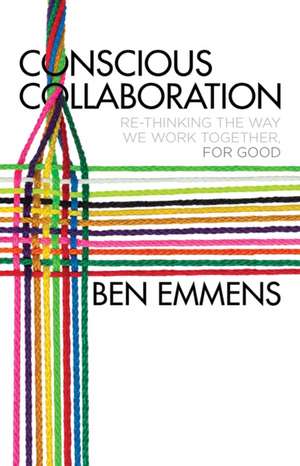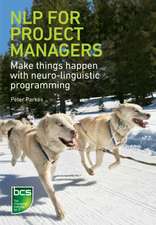Conscious Collaboration: Re-Thinking The Way We Work Together, For Good
Autor Ben Emmensen Limba Engleză Hardback – 17 noi 2016
Collaboration and partnerships work well in the aid sector because they have to – no one body has the resources to solve massive problems on their own. Business often sees the advantages of collaboratively sharing costs without fully recognizing the shift in mindset that is required to take managers with a “winner takes all” worldview and get them performing effectively in a win-win world.
Part of the solution lies in bringing consciousness to the workplace and developing it as a core competence. A conscious approach to business relationships, planning, and delivery can enable individuals and organizations to truly think about what they are doing, make changes where needed, and become more effective. It is a particularly effective way of managing the multiple and occasionally conflicting stakeholder objectives inherent in any collaborative project. The author draws on his experience in the aid sector and with non-profit organizations to describe the building blocks that underpin successful collaboration, and inspires us to re-think the way we work together, for good.
Preț: 237.79 lei
Nou
Puncte Express: 357
Preț estimativ în valută:
45.51€ • 49.41$ • 38.23£
45.51€ • 49.41$ • 38.23£
Carte disponibilă
Livrare economică 01-15 aprilie
Livrare express 15-21 martie pentru 29.31 lei
Preluare comenzi: 021 569.72.76
Specificații
ISBN-13: 9781137538031
ISBN-10: 1137538031
Pagini: 224
Ilustrații: XXV, 211 p. 38 illus.
Dimensiuni: 148 x 210 x 19 mm
Greutate: 0.44 kg
Ediția:2016
Editura: Palgrave Macmillan UK
Colecția Palgrave Macmillan
Locul publicării:London, United Kingdom
ISBN-10: 1137538031
Pagini: 224
Ilustrații: XXV, 211 p. 38 illus.
Dimensiuni: 148 x 210 x 19 mm
Greutate: 0.44 kg
Ediția:2016
Editura: Palgrave Macmillan UK
Colecția Palgrave Macmillan
Locul publicării:London, United Kingdom
Cuprins
PART ONE: THE COLLABORATIONCONUNDRUM.- 1. 'Collaborate' or 'fragmentate'.- 2. 'Collaborative DNA?'.- 3.'The partnership vortex'.- 4. 'Collaborative capital'.- PART TWO: CONSCIOUSCOLLABORATION.- 5. 'Conscious collaborators'.- 6. 'Generosity and humility'.-7. 'Accompaniment'.- 8. 'The edge of the inside'.- 9. 'The porous edge'.- 10.'Trust on credit'.- 11. 'Jamming'.- 12. 'The virtual guild'.- PART THREE:ACTION 13. Leadership.- 14. Principles and processes.- 15. Micro-outcomes.- 16.Conclusion
Notă biografică
Benhas worked in the aid sector for the last 15 years, holding a range of rolesthat have seen him work with humanitarian and development agencies in more 40countries. He spent ten years with People In Aid, an umbrella organization thatprovided HR and people management support to those working to reduce inequalityand alleviate suffering. Prior to his career in the aid sector, he held a rangeof roles in the private and public sectors.
He isthe co-founder of The Conscious Project, a social business that typically worksat Board, Executive, or senior management level and whose client list includesUNICEF, the Red Cross, Action Aid, Save the Children, Oxfam, CARE, WorldVision, the International Rescue Committee, the International Water ManagementInstitute, International Food Policy Research Institute, the Scout Association,Amnesty International, the Pakistan Humanitarian Forum, and the National HealthService.
He isthe co-founder of The Conscious Project, a social business that typically worksat Board, Executive, or senior management level and whose client list includesUNICEF, the Red Cross, Action Aid, Save the Children, Oxfam, CARE, WorldVision, the International Rescue Committee, the International Water ManagementInstitute, International Food Policy Research Institute, the Scout Association,Amnesty International, the Pakistan Humanitarian Forum, and the National HealthService.
Textul de pe ultima copertă
When collaboration works, the results can be breath-taking! But it doesn’t always deliver on its potential. Collaboration has been defined as "an unnatural act practiced by non-consenting adults". And often that’s exactly what it is! Some collaboration can be painfully difficult with the result that problems are either ignored or smoothed over until the collaboration falters or disintegrates, or self-interest and personal agendas take over and conflict quickly arises.
Collaboration and partnerships work well in the aid sector because they have to – no one body has the resources to solve massive problems on their own. Business often sees the advantages of collaboratively sharing costs without fully recognizing the shift in mindset that is required to take managers with a “winner takes all” worldview and get them performing effectively in a win-win world.
Part of the solution lies in bringing consciousness to the workplace and developing it as a core competence. A conscious approach to business relationships, planning, and delivery can enable individuals and organizations to truly think about what they are doing, make changes where needed, and become more effective. It is a particularly effective way of managing the multiple and occasionally conflicting stakeholder objectives inherent in any collaborative project.
The author draws on his experience in the aid sector and with non-profit organizations to describe the building blocks that underpin successful collaboration, and inspires us to re-think the way we work together, for good.
Collaboration and partnerships work well in the aid sector because they have to – no one body has the resources to solve massive problems on their own. Business often sees the advantages of collaboratively sharing costs without fully recognizing the shift in mindset that is required to take managers with a “winner takes all” worldview and get them performing effectively in a win-win world.
Part of the solution lies in bringing consciousness to the workplace and developing it as a core competence. A conscious approach to business relationships, planning, and delivery can enable individuals and organizations to truly think about what they are doing, make changes where needed, and become more effective. It is a particularly effective way of managing the multiple and occasionally conflicting stakeholder objectives inherent in any collaborative project.
The author draws on his experience in the aid sector and with non-profit organizations to describe the building blocks that underpin successful collaboration, and inspires us to re-think the way we work together, for good.









